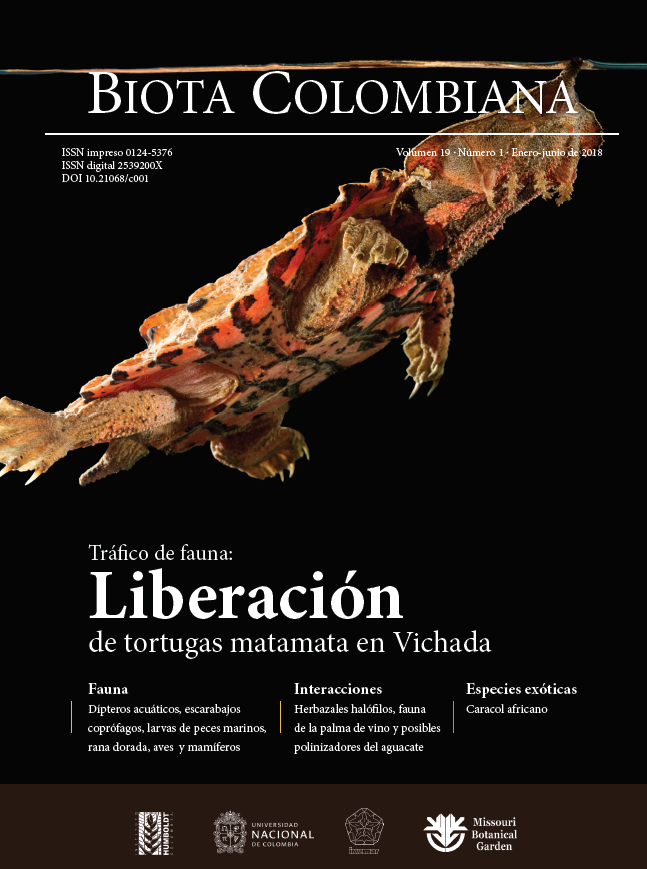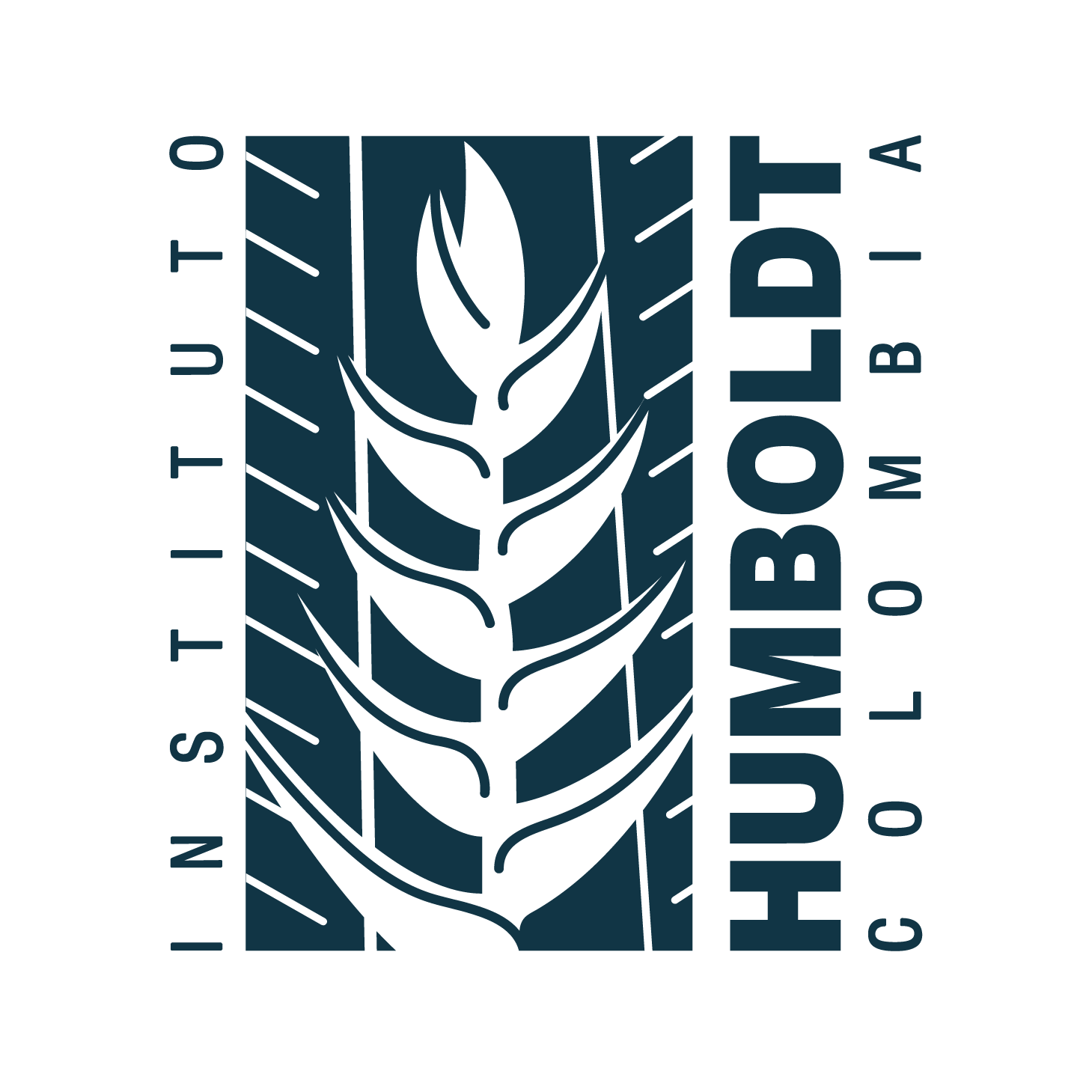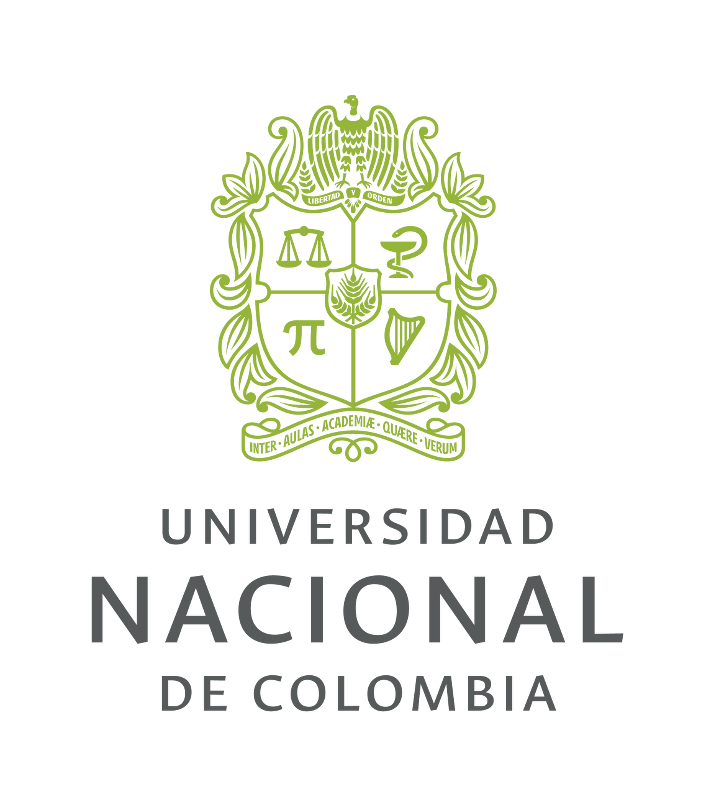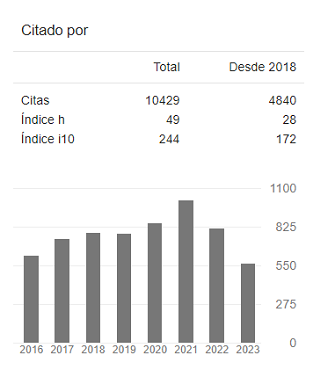Resumen (es):
La fragmentación es de nida como el proceso de trasformación de un hábitat natural en parches de menor área, aislados entre sí e inmersos en matrices de menor cobertura vegetal. Los parches resultantes quedan expuestos a las condiciones del ambiente exterior o efectos de borde, que pueden ocasionar cambios en la estructura y regeneración de las comunidades vegetales. En esta investigación se evaluó el efecto de borde sobre la estructura, diversidad y potencial de regeneración de plantas leñosas en dos fragmentos de bosque seco. Se registró un proceso activo de regeneración natural, sin embargo, no se encontró un efecto de borde sobre las variables estudiadas para ambos fragmentos. La ausencia de efecto de borde podría estar dada por el tiempo transcurrido desde la formación del fragmento. Durante este tiempo han estado activos los procesos de regeneración, dando lugar a una vegetación de estructura y composición similar en todo el bosque. También se observó que las matrices de estos fragmentos constituyen una barrera para su expansión y conectividad, y para superarla se hace necesaria la implementación de estrategias que favorezcan la dispersión de semillas hacia el exterior y, se optimicen las condiciones para la germinación y el establecimiento de los nuevos propágulos.
Resumen (en):
Palabras clave:
Edge effect, Fragmentation, Recruitment, Sapling, Seedlings (en)
Referencias
Albornoz, F. E., Gaxiola, A., Seaman, B. J., Pugnaire, F.I. y Armesto J.J. (2013) Nucleation- driven regeneration promotes post- re recovery in a Chilean temperate forest. Plant Ecology, 214, 765–776.
Arcila, A. M., Valderrama C. y Chacón P. ( 2012). Estado de fragmentación del bosque seco de la cuenca alta del río Cauca, Colombia. Biota Colombiana, 13, 86-101.
Benítez-Malvido, J. (1998). Impact of forest fragmentation on seedling abundance in a tropical rain forest.Conservation Biology, 12(2), 380-389.
Benítez-Malvido, J. y Lemus-Albor, A. (2005). The seedling community of tropical rain forest edges and its interaction with herbivores and pathogens. Biotropica, 37, 301-313.
Botzat, A., Fischer, L., y Farwig, N. (2015). Regeneration potential in South African forest fragments: extinction debt paid off or hampered by contemporary matrix modi cation?. Plant Ecology, 216(4), 535-551.
Bouroncle, C., y Finegan, B. (2011). Tree regeneration and understory woody plants show diverse responses to forest–pasture edges in Costa Rica. Biotropica, 43(5), 562-571.
Brandão, J. D. F. C., Martins, S. V. y Brandão, I. J. (2016). Potencial de regeneração de uma área invadida por Pteridium aquilinum (L.) Kuhn no parque nacional do caparaó. Floresta, 46(4), 543- 552.
Cavender-Bares, J. y Bazzaz F. (2000). Changes in drought response strategies with ontogeny in Quercus rubra: implications for scaling from seedlings to mature trees. Oecologia, 124, 8-18.
Chen, J., Saunders, S., Crow, T., Naiman, R., Brosofske, K., Mroz, G., Brookshire, B., Franklin, J. F. (1999) Microclimate in Forest Ecosystem and Landscape Ecology: Variations in local climate can be used to monitor and compare the effects of different management regimes. BioScience, 49 (4), 288-297, https://doi.org/10.2307/1313612
Comita, L. S., Queenborough, S. A., Murphy S. J., Eck, J. L., Kaiyang, X., Krishnadas, M., Beckman, N., y Zh, Y. (2014). Testing predictions of the JanzenConnell hypothesis: a meta-analysis of experimental evidence for distance and density- dependent seed and seedling survival. Journal of Tropical Ecology, 102, 845-856.
Corbin, J. D. y Holl, K. D. (2012). Applied nucleation as a forest restoration strategy. Forest Ecology and Management, 265, 37-46.
Cubiña, A. y Aide M, T. (2001). The effect of distance from forest edge on seed rain and soil seed bank in a tropical pasture. Biotropica, 33(2), 260-267.
Dewalt, S. J., Taylor, B. N. y Ickes, K. (2015). Density- dependent Survival in Seedlings Differs among Woody Life-forms in Tropical Wet Forests of a Caribbean Island. Biotropica, 47, 310-319.
Fahrig, L. (2003). Effects of habitat fragmentation on biodiversity. Annual review of ecology, evolution, and systematics, 34(1), 487-515.
Faraway, J. (2016). Extending the linear model with R: generalized linear, mixed effects and nonparametric regression models. USA: CRC Press. 312 pp.
Fischer, J. y Lindenmayer, D. B. (2007). Landscape modi cation and habitat fragmentation: a synthesis. Global ecology and biogeography, 16(3), 265-280.
Fletcher, Jr., Ries, R. J., Battin, L. y Chalfoun A. D. (2007). The role of habitat area and edge in fragmented landscapes: de nitely distinct or inevitably intertwined? Canadian journal of zoology, 85 (10), 1017-1030.
García, H., Corzo, G., Isaacs, P. y Etter, A. (2014). Distribución y estado actual de los remanentes del bioma de bosque seco tropical en Colombia: insumos para su gestión. Pp: 229-241. En Pizano, C. y García, H. El Bosque Seco Tropical en Colombia (349 pp). Bogotá, D.C., Colombia. Instituto de Investigación de Recursos Biológicos Alexander von Humboldt.
Grubb, P. J. (1977). The maintenance of species- richness in plant communities: the importance of the regeneration niche. Biological reviews, 52 (1), 107-145.
Hammer, Ø., Harper, D. A. T. y Ryan, P. D. (2001). Paleontological Statistics Software: Package for Education and Data Analysis. Paleontologia Electronica.
Harper, K. A., Macdonald, S. E., Burton, P. J., Chen, J., Brosofske, K. D, Saunders, S. C., y Esseen, P. A. (2005). Edge in uence on forest structure
and composition in fragmented landscapes. Conservation Biology, 19(3), 768-782.
Holl, K. D. 1999. Factors limiting tropical rain forest regeneration in abandoned pasture: seed rain, seed germination, microclimate, and soil. Biotropica, 31(2), 229-242.
Holl, K. D., Loik, M. E, Lin, E. H. e Samuels I. A. (2000). Tropical montane forest restoration in Costa Rica: overcoming barriers to dispersal and establishment. Restoration ecology, 8(4), 339-349.
Janzen, D. H. 1988. Management of Habitat Fragments in a Tropical Dry Forest: Growth. Annals of the Missouri Botanical Garden, 75(1), 105- 116.
Laurance, W. F., Lovejoy T. E., Vasconcelos H. L., Bruna E. M., Didham R. K., Stouffer P. C., y Sampaio E. ( 2002). Ecosystem decay of Amazonian forest fragments: a 22 - year investigation. Conservation Biology, 16(3), 605- 618.
Laurance, W. F., Nascimento, H. E., Laurance, S. G., Andrade, A. C., Fearnside, P. M., Ribeiro, J. E., y Capretz, R. L. (2006). Rain forest fragmentation and the proliferation of successional trees. Ecology, 87 (2), 469-482.
Lopes, A. V., Girão, L. C., Santos, B. A., Peres, C. A. y Tabarelli M. (2009). Long-term erosion of tree reproductive trait diversity in edge-dominated Atlantic forest fragments. Biological Conservation, 142 (6), 1154-1165.
Lozano, F. H., Vargas, W., Caicedo, P. C., Jiménez, E., Guerra, G. y Cardona, C. A. (2007). Herramientas de manejo del paisaje para favorecer el mantenimiento y la restauración del bosque seco tropical en el valle geográ co del río cauca. Informe para el Instituto de Investigación de Recursos Biológicos Alexander von Humboldt.
Miles, L., Newton, A. C., DeFries, R. S., Ravilious, C., May, I., Blyth, S., y Gordon, J. E. (2006). A global overview of the conservation status of tropical dry forests. Journal of Biogeography, 33(3), 491-505.
Mok, H.-F., Arndt, S. K. y Nitschke, C. R. (2012). Modelling the potential impact of climate variability and change on species regeneration potential in the temperate forests of South- Eastern Australia. Global Change Biology, 18, 1053-1072. doi:10.1111/j.1365-2486.2011.02591.x
Molina, C., Molina, C., Molina, E. y Molina J. (2012). Manejo agroecológico de caña de azúcar y sistemas silvopastoriles intensivos Alternativas sostenibles para el valle geográ co del río Cauca. Reserva Natural El Hatico. RevistaTecnicaña, 29, 28-35.
Murcia, C. (1995). Edge effects in fragmented forests: implications for conservation. Trends in ecology & evolution, 10 (2), 58-62.
Murphy, P. G., y Lugo, A. E. (1986). Ecology of tropical dry forest. Annual Review of Ecology and Systematics, 17, 67-88.
Norden, N., Chave, J., Caubere, A., Chatelet, P., Ferroni, N., Forget, P. M. y Thébaud, C. (2007). Is temporal variation of seedling communities determined by environment or by seed arrival? A test in a neotropical forest. Journal of Ecology, 95 (3), 507-516.
Norden N. (2014). Del porqué la regeneración natural es tan importante para la coexistencia de especies en los bosques tropicales. Colombia Forestal, 17 (2), 247-261.
Phillips, O. L., Rose, S., Mendoza, A. M., y Vargas, P. N. (2006). Resilience of southwestern Amazon forests to anthropogenic edge effects. Conservation Biology, 20(6), 1698-1710.
Pizano, C. y García, H. (2014). El bosque seco tropical en Colombia. Bogotá, D.C., Colombia. Instituto de Investigación de Recursos Biológicos Alexander von Humboldt.
Poorter, L. y Markesteijn L. (2008). Seedling traits determine drought tolerance of tropical tree species. Biotropica, 40 (3), 321-331.
Ries, L., Fletcher, Jr. R. J., Battin, J. y Sisk, T. D. (2004). Ecological responses to habitat edges: mechanisms, models, and variability explained.
Annual Review of Ecology, Evolution, and Systematics, 35, 491-522.
R Core Team. (2014). R: a language and environment for statistical computing, R Foundation for Statistical Computing, Vienna, Austria, available at: www.r-project.org (accesed September 2015).
Rojas, O. (1991). Evolución de una sucesión vegetal en el Valle del Cauca: Generalidades sobre el estudio de la dinámica de regeneración en el Santuario de El Vínculo. Cespedesia, 13 (49-50), 152-221.
Sampaio, A. B. y Scariot, A. (2011). Edge effect on tree diversity, composition and structure in a deciduous dry forest in central Brazil. Revista Árvore, 35 (5), 1121-1134.
Saunders, D. A., Hobbs, R. J. y Margules C. R. (1991). Biological consequences of ecosystem fragmentation: a review. Conservation Biology, 5 (1), 18-32.
Silverstone-Sopkin, P. A. (2011). Los muertos vivientes: la historia natural de cuatro lirios amazónicos del suroccidente de Colombia. 100 pp. Cali, Colombia: Programa Editorial, Universidad del Valle.
Sizer, N., y Tanner, E. V. (1999). Responses of woody plant seedlings to edge formation in a lowland tropical rainforest, Amazonia. Biological Conservation, 91 (2), 135-142.
Torres, A. M., Adarve, J. B., Cárdenas, M., Vargas, J .A., Londoño, V., Rivera, K., Home, J., Lucía, O. y María, Á. (2012). Dinámica sucesional de un fragmento de bosque seco tropical. Biota Colombiana, 13, 66-85.
Vargas-Rodriguez, Y. L., Vázquez-García, J. A. y Williamson, G. B. (2005). Environmental correlates of tree and seedling-sapling distributions in a Mexican tropical dry forest. Plant Ecology, 180, 117-134.
Vieira, D. L. y Scariot A. (2006). Principles of natural regeneration of Tropical Dry Forests for regeneration. Restoration Ecology, 14, 11-20.
Williams-Linera, G. (1990). Vegetation Structure and Environmental Conditions of Forest Edges in Panama. The Journal of Ecology, 78, 356-373.
Williams-Linera, G. y Lorea F. (2009). Tree species diversity driven by environmental and anthropogenic factors in tropical dry forest fragments of central Veracruz, México. Biodiversity and Conservation, 3269-3293.
Cómo citar
Las obras publicadas en las revistas del Instituto de Investigación de Recursos Biológicos Alexander von Humboldt están sujetas a los siguientes términos, con relación al derecho de autor:
1. Los derechos patrimoniales de las obras publicadas tienen como titular al Instituto de Investigación de Recursos Biológicos Alexander von Humboldt. Los autores o las instituciones que elaboran el documento aceptan ceder los derechos patrimoniales al Instituto Humboldt con el envío de sus artículos, lo que permite –entre otras cosas– la reproducción, comunicación pública, difusión y divulgación de las obras.
2. Las obras de ediciones digitales se publican bajo una licencia de Creative Commons Colombia:
Esta obra está bajo una Licencia Creative Commons Atribución-NoComercial-SinDerivar 4.0 Internacional.
Atribución – No comercial – Sin Derivar: Esta licencia es la más restrictiva de las seis licencias principales, sólo permite que otros puedan descargar las obras y compartirlas con otras personas, siempre que se reconozca su autoría, pero no se pueden cambiar de ninguna manera ni se pueden utilizar comercialmente.
3. Los autores, al someter artículos al proceso editorial de las revistas editadas por el Instituto Humboldt, aceptan las disposiciones institucionales sobre derechos de autor y acceso abierto.
4. Todos los artículos recibidos serán sometidos a un software antiplagio. El sometimiento de un artículo a las revistas del Instituto Humboldt se entiende como la aceptación de la revisión para detectar posible plagio.
5. Las obras sometidas al proceso de edición de las revistas del Instituto Humboldt deben ser inéditas.


















